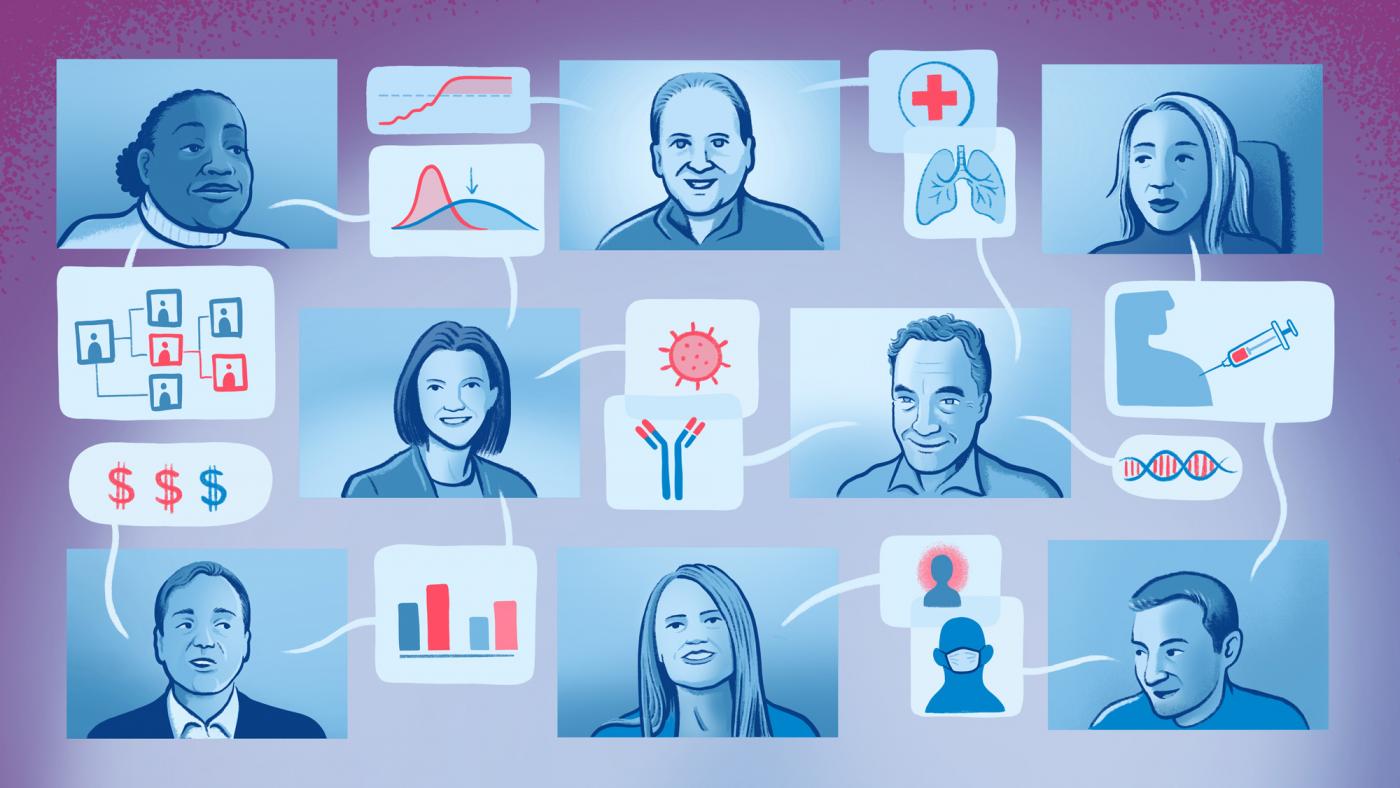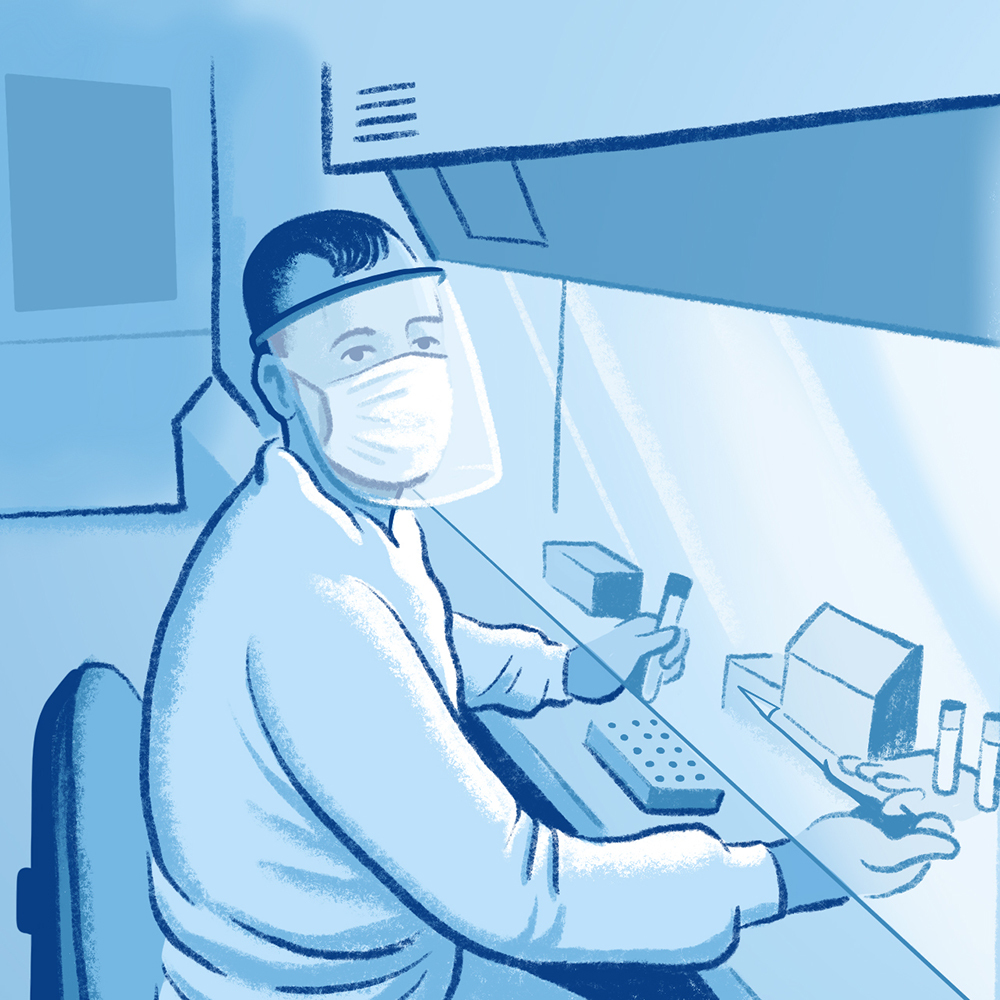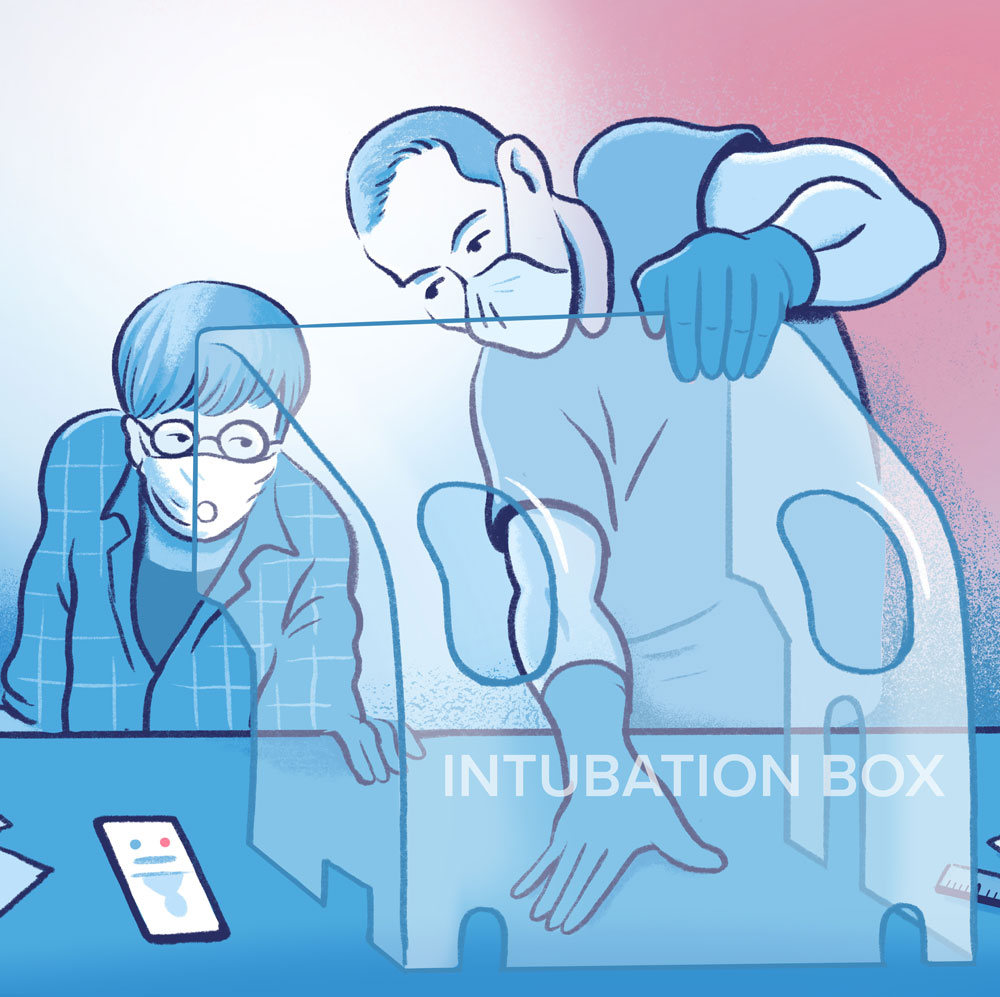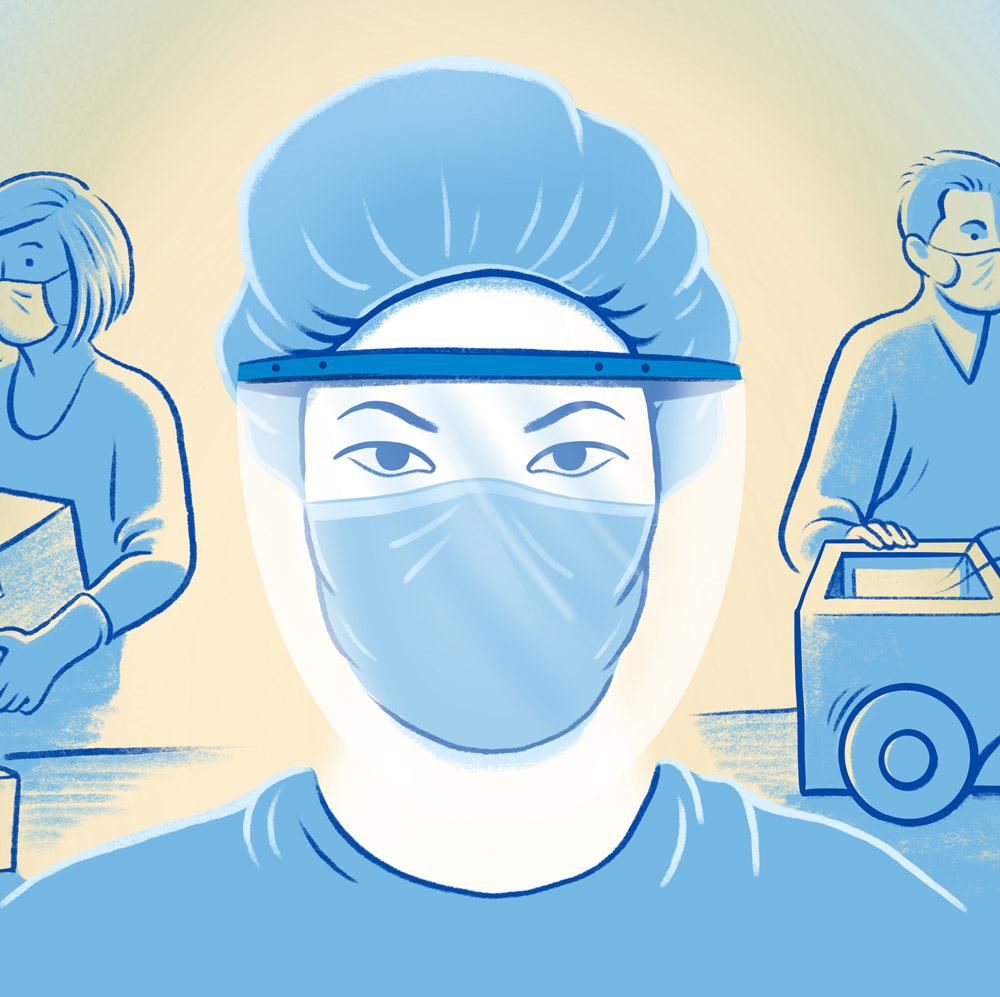KATHLEEN DURKIN I’m Kathleen Durkin of Columbia’s Zuckerman Institute.
DEVIN POWELL And I’m Devin Powell of the Zuckerman Institute.
KATHLEEN Welcome to Lab in the Time of Coronavirus.This podcast follows the lives of scientists at our Institute and at Columbia University who are pivoting to combat COVID-19 in this time of crisis.
DEVIN Today we’re exploring an online gathering, where scientists and scholars at the forefront of dealing with COVID are coming together to share their latest research. Their talks at the Columbia Virtual COVID Symposium draw an audience of hundreds every week. And our story starts with a talk given on April 15.
KATHLEEN Think back to mid-April. Things were bad in Italy. There were 160,000 cases of COVID, and the numbers were rising. But two doctors in Bologna, Italy, took the time to hop on Zoom and share their experience.
DEVIN And here at Columbia, a pulmonologist named Jeanine D’Armiento, MD, PhD, a Columbia associate professor of medicine who was in the middle of dealing with the New York COVID outbreak, tuned in to learn from the Italian experience.
This is a virus that kills people now. And we think that being absolutely open and sharing everything, including data, methodologies and reagents is going to be absolutely the way to go.
JEANINE D’ARMIENTO At the time we heard that talk we were still in the middle of chaos, patients coming in, patients coming in, no chance to think about the clinical issues. And they being from Italy had already begun to think about that.
KATHLEEN The two doctors from Bologna, Dr. Massimo Baiocchi and Dr. Maria Benedetto, had recognized that COVID wasn’t your typical ARDS. You’ll hear this acronym again. It stands for acute respiratory distress syndrome, or ARDS.
DEVIN Dr. D’Armiento had noticed that, too. Her patients had unusually severe oxygen deprivation in their blood, which doctors call hypoxia.
JEANINE These patients become incredibly hypoxic, suddenly. Normally an ARDS patient, if they have the flu or something, they come in, and they’re a little bit hypoxic. It takes time, and there’s not this big sudden event. We had the sense that if you can catch the patients before they crash then you can avoid the ventilator hopefully. My colleagues and I had been talking about some of what they were doing.
KATHLEEN The Italian doctors were using the gas nitric oxide, which regulates the body’s response to hypoxia. This is not standard procedure in New York, but it’s something D’Armiento wants doctors here to think about.
JEANINE A lot of us who think about what’s going on really want this to be considered. To hear that they were doing it, it was like oh great, we’re all on the same page.
DEVIN Exchanging knowledge like this and making connections between those at the forefront of dealing COVID is what the Columbia symposium is all about.
ANDREA CALIFANO The COVID symposium essentially it’s a way to share the collective imagination of one of the most talented groups of scientists in the world that are here at Columbia. It has been extended to share the imagination of researchers throughout the United States and the world.
KATHLEEN That’s Andrea Califano, PhD, one of the organizers of the symposium. He’s founding chair of the Department of Systems Biology at Columbia University Irving Medical Center.
ANDREA This is a virus that kills people now. And we think that being absolutely open and sharing everything, including data, methodologies and reagents is going to be absolutely the way to go.
DEVIN The symposium was organized in a matter of days. And it drew a much larger crowd than anticipated, right from the start.
ANDREA One of the really striking things has been the speed. The first symposium was organized in three days. The night before, we realized that we were going to have more than 1,000 users that would potentially be interested in following the symposium. Our original webcasting was for 300 people. In the end we ended up having 935. Fortunately, we were able at the very last minute to change and have 1,000 seats.
KATHLEEN To handle this massive online gathering, Dr. Califano recruited Kelley Remole, PhD. She’s the Senior Director of Programs at the Zuckerman Institute.
KELLEY REMOLE As someone who oversees both public-facing events and events that bring together scientists across disciplines, I was positioned to put in place the structure of an even bigger effort and stage to bring COVID researchers together from across the University. We pushed the announcement of those seminars to 14,000 people across the University, and the response was overwhelming
DEVIN The team also enlisted volunteers to help get the talks onto YouTube.
KATHLEEN We’ve been listening to these talks, like the one given by the Italian doctors. In another one of them, Andrea Califano presents his latest genetics work.
DEVIN Instead of focusing on the virus itself, which is constantly mutating, constantly changing, Dr. Califano is investigating the host environment in our bodies that the virus infects. He hopes that this approach will lead to new kinds of treatments.
ANDREA So what we’re trying to do is to really understand how the virus actually interacts with the host system because the proteins in the host system will not mutate as rapidly. Therefore whatever works today, if you find a good recipe, will also work tomorrow. In fact, there’s a drug among the ones we have prioritized that is already in clinical trials for COVID-19 and hopefully will also be at Columbia.
KATHLEEN One talk that people have been reacting to was given by Allison Norful, PhD, RN, ANP-BC, a Columbia Nursing scientist. She’s been studying the stresses that healthcare workers are experiencing and some of the solutions that are helping.
ALLISON NORFUL Surprisingly, burnout decreased. But there was excessive worry. There are high anxiety levels, generally surrounding transmission to the home. Some of the strategies that are being used to improve clinician well-being are support groups, both virtually and on-site. Some talked about the increased amount of teamwork that has increased their sense of resilience. Something very positive is a change in workflow to encourage on-site breaks, when possible. There’s also celebrating daily goals. This, according to the perspectives of the workforce, is having a great impact on their own physical and psychological health.
DEVIN David Brenner, PhD, a theoretical physicist at Columbia, talked about using ultraviolet light to kill COVID in the environment.
KATHLEEN UV light is not a medical treatment in any way. But it effectively kills the virus in the air and on surfaces outside the human body.
DAVID BRENNER We actually know how to kill every possible kind of microbe, bacteria, virus, and that’s with ultraviolet light. And we’ve known that for 100 years. The issue with conventional germicidal UV is that it’s a health hazard. It causes skin cancer. It causes eye disease. We started to think about far UVC light. That’s at the far end of the ultraviolet spectrum. In principle, at least, far UVC light has the same germicidal properties as conventional UV but is potentially safe.
KATHLEEN As the symposium enters its second month, Andrea Califano and the other organizers are trying to further broaden its reach.
DEVIN They’re trying to create a big tent: a welcoming forum for scholars who study everything from data visualization techniques for COVID-19 to the racial disparities brought to light in this crisis.
ANDREA We started from a very molecular perspective, very driven by the classical approach to virology studies. But we’re now bifurcating, trifurcating, quadrifurcating into all sorts of different ways in which you can think about this problem. What are the economic implications? What are the potential social and gender, racial implications that would bring different perspectives to bear?
DEVIN One example of this interdisciplinary focus is Robert Farrokhnia. He’s a Columbia faculty member with appointments in business and engineering, and lecturer in the graduate school of journalism.
KATHLEEN He’s been studying people’s spending habits during the pandemic.
ROBERT FARROKHNIA As expected, in our results supermarket and grocery and pharmacy spending went up as restaurants and transport went down. But obviously there’s some interesting nuances that you see. For instance, for public transport we saw a spike toward the end of February, early March. That’s perhaps attributed to folks going home or wanting to shelter in place with parents or family, but then it dramatically went down right afterwards.
DEVIN His data also revealed some surprises that challenge certain narratives centered on political affiliation out there in the media.
ROBERT We saw that, contrary to what you might hear in the news, in general those identifying as Republican versus Democrats more or less behave similarly. They seem to care more for the well-being of family and survival more than politics.
KATHLEEN The symposium has given birth to many new collaborations. Dr. Farrokhnia was no exception. After his talk, he was approached by other scholars interested in working with his data.
ROBERT One of the most exciting parts of our presentation was me mentioning seeking collaborators. And to my delight we had a number of researchers, including faculty and postdocs and PhD students who were working on related projects, and I’m more than happy to provide open access and active discussion in creating a framework to scale our activity and do more research along those lines. So that was probably one of the most exciting outcomes of our presentation at the symposium.
DEVIN Organizing the COVID symposium has been a lot of work. But Kelley Remole says that the impact it has had makes it all worthwhile.
KELLEY There’s been an outpouring of good will and appreciation for this pan-Columbia effort. The responses actually amazed me, from the Business School and Public Health and Nursing to the Law School and Economics and just really every corner of Columbia, all of a sudden had faculty and post-docs and adjuncts really interested in this topic. And that is testament to how this force of Columbia is really mobilizing against this brand new foe. People just keep saying, “Thanks for doing this. This is amazing. I don’t know how else I would get this information. This is so appreciated.”
KATHLEEN Thanks for listening to Lab in the Time of Coronavirus. Take a look at the show notes for links to all the things we discussed, including links to YouTube recordings of many of the presentations.. You can find all of our episodes at https://zuckermaninstitute.columbia.edu or on iTunes. Take a moment to rate and review us on iTunes. That makes it easier for other people to find us.
DEVIN And if you’d like to learn more about Columbia’s COVID-19 Virtual Symposium, check out the Zuckerman YouTube channel. Special thanks to Rui Costa, Jennifer Farris, the researchers who sat down with us for this episode, and the entire Zuckerman team. The music was provided, as usual, by Miguel Zenón, Jazz Artist-in-Residence at the Zuckerman Institute. If you have thoughts or questions, you can find us on Twitter and Instagram @ZuckermanBrain. But before we go, Kathleen I think you had one last question for the folks we interviewed.
KATHLEEN What is the first thing you plan to do, post-pandemic?
JEANINE After this pandemic, I’m going to go see my mother, give her a hug, and then my entire family is going to the beach for a week.
ANDREA The first thing I’m going to do is to have three omakase in a row at my favorite sushi restaurant.
KELLEY I want to send my kids back to school to be with their friends and have a dinner party with my friends.
ROBERT I miss my office at the Columbia campus dearly. I’d love to be able to go back and grab all the books I left in there that I no longer have access to.
Note: This transcript has been edited for clarity.



